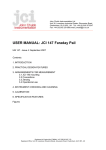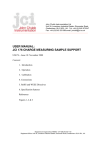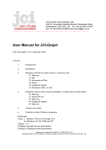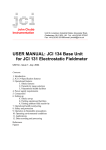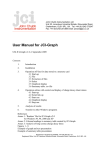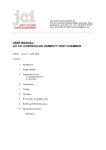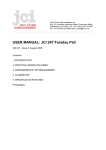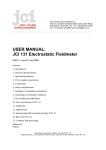Download User Manual: JCI 140 Static Monitor
Transcript
John Chubb Instrumentation Ltd Unit 30, Lansdown Industrial Estate, Gloucester Road, Cheltenham, GL51 8PL, UK. Tel: +44 (0)1242 573347 Fax: +44 (0)1242 251388 email: [email protected] ______________________________________________________________________________________________ User Manual: JCI 140 Static Monitor UM140 issue 21: September 2007 Contents: 1. Introduction 2. The JCI 140 Static Monitor 3. Use of instrument 4. CE Conformance 5. RoHS and WEEE Directives 6. Specification features Registered in England No 5798844. VAT GB 392 007 172 Registered Office: Unit 30, Lansdown Industrial Estate, Gloucester Road, Cheltenham, GL51 8PL, UK USER MANUAL - JCI 140 STATIC MONITOR A compact instrument for easy, sensitive and reliable measurements and for monitoring of electrostatic conditions 1. INTRODUCTION Static electricity causes problems in many areas of industry: • ignition of flammable gases • shocks to personnel • attraction of airborne dust and debris • cling of thin films and light fabrics • damage to semiconductor devices • upset of operation of microelectronic system operation - and on the other and there are many constructive applications for static electricity. Static electricity arises when materials in contact are separated and the speed of charge movement on either surface and away to earth is long compared to the time for the surfaces to move apart. Many operations in industry and normal life involve the contact and separation of materials that are poor or bad conductors of electricity - notably plastics. Common examples are the occurrence of sparks when combing the hair or taking off an acrylic jumper, shocks when getting out of a car and shocks after walking across a nylon carpet and touching earthed conductors. The separation of such surfaces is often associated with retention of static charge. Voltages of several thousand volts (and up to 20kV) can be generated on our bodies as we go about normal daily activities. When we touch a metal object and feel a shock or, for example, when we hear a crackle as we take off an acrylic jumper we create an electrical discharge. This may give us a shock, damage a microelectronic circuit or couple into the computer and upset computer operation. Manufacturing operations may involve the handling of thin sheet materials - for instance in the printing and packaging industries. Static can cause sheets to stick together or be attracted to nearby surfaces. This attraction is a particular problem with lingerie that may tend to cling to the body. It will cause attraction of dust and debris from the air - so packages become 'dirty' when left on the Supermarket shelf. With powders (for instance in the pharmaceutical industry) material flow may be restricted. In flammable atmospheres static build up leading to the occurrence of sparks can cause explosions and fires - with the risk of loss of life and damage to plant and people. Controlling static: The secret is to prevent any major build-up of static on people, on industrial plant or on materials. This requires effective linking to 'earth'. With metal plant and equipment this means good and reliable earth bonding - links you can see and check. With many materials it is not so easy. Most plastics are bad conductors of electricity - i.e. charge does not move easily over or through the material. To enable such materials to dissipate static fairly quickly they need to have additives included in their manufacture or have surface treatment. Static charge needs to be able to leak away to earth over and through materials within a fraction of a second. Role of measurements: How do you know if you have problems with static, how do you find the source and cause of problems, how do you know if remedial actions are effective and how do you choose appropriate material? The answer is measurements. JCI manufactures a number of instruments to measure static conditions and to assess the suitability of materials for particular applications and to avoid risks and problems (JCI 155v5 Charge Decay Test Unit). 2. THE JCI 140 STATIC MONITOR The JCI 140 is a compact sensitive 'field mill' instrument set to measure the voltage of surfaces at a defined distance. The voltage sensitivity can be switched between 2000 and 20,000 volts full scale for 100mm (4") separation. Measurements are shown on a 3½ digit liquid crystal display with decimal point and low battery indication. An audio alarm gives warning of any voltages above a user set threshold level. The electric field sensitivity at the -1 sensing aperture is about 23V m for a reading of .001 on the 2kV range. The frequency response of instruments enables measurements to be made of voltages and electric fields created by mains frequency sources. As a 'field mill' instrument there is no need to switch-on in a 'static free' environment and no need for measurements to be made within a limited time - as applies with simple 'induction probe' type instruments. The novel mode of operation of the JCI 140, with no earthing of the rotor, provides quiet, stable operation with fast response and long operational life. Interpretation of the readings obtained with the JCI 140 needs to be approached with care. For instance, a charged plastic film lying on an earthed surface may show only a low surface voltage - but this (and the associated electrostatic energy) can increase dramatically when it is lifted up. The significance of readings depends very much on the practical situation and the type of risk or problem involved. The user needs to be aware of the need to assess the significance of readings appropriately. If in doubt it will be helpful to consult some of the Codes of Practice or Standards available, for example 'The control of undesirable static electricity' BS 5958: Part 1: 1991 and/or 'Methods for measurements in electrostatics' BS 7506: Part 1: 1995 and Part 2: 1996. There are also the Notes from the ‘Introductory Workshop in Electrostatics’ on the JCI Website (www.jci.co.uk/Electrostatics/Wshop00.html). 3. USE OF INSTRUMENT 3.1 Getting started: By the time you read this User Manual you will already have opened the JCI 140 carrying case. Now take out the instrument. Hold the instrument in the hand with the liquid crystal display upwards and the gold plated sensing aperture away from the body. Take the earth bonding lead (yellow) out of the case and connect it to the 'earth bonding point' on the right hand side of the back of the instrument. Connect the other end of the lead to an earth point using either the 'Durable Dot' connector or the crocodile clip. Now switch on the instrument. The ON/OFF switch (with the black slider) is towards the top right hand side of the back plate. The switch has 3 positions: left is off, middle is ON for a sensitivity of 2000V full scale and fully to the right is for a sensitivity of 20,000V full scale. When the instrument is switched on you should hear the motor inside start and see the LCD start to show numbers. A piece of plastic (polythene bag, biro shaft) rubbed and held in front of the sensing aperture will make the displayed numbers change - and give larger readings when closer. 3.2 Aspects of operational use: Earth bonding: The instrument needs to be bonded to earth via the bonding point on the back if the readings are to be meaningful. Handheld operation: The instrument can be held by the side grooves with the display uppermost facing towards the operator. The hand should be towards the rear of the instrument to minimise the influence on sensitivity. Switch-on: The instrument is switched on by the slide switch at the right side of the back 2 surface. The switch positions are marked 0 for 'off', 1 for the +2 kV range of sensitivity and 2 for the +20 kV range. Static conditions at switch-on: No special precautions need be taken about electric fields around the instrument at switch-on. Zeroing: It is best to use a clean metal cup over the sensing aperture touching the front of the instrument for checking the zero reading and during zero adjustment. (A hand over the sensing aperture is convenient but not as good). The zero setting is adjusted through hole 'Z' in the back plate. Allow a few seconds for stabilising after switch-on or adjustment. Sensitivity: The analogue output signal may be used for remote display and for recording on a paper chart recorder or using a digital storage oscilloscope (e.g. a Picoscope). While the sensitivity is manually set for low sensitivity the operating sensitivity can be controlled remotely by holding the range output line high (+5V) to select the 2kV range. The sensitivity varies with separation distance from surfaces as shown: VARIATION OF SENSITIVITY OF JCI 140 WITH DISTANCE Reading for 1kV on large plate: 3 2.5 2 1.5 1 0.5 0 0 20 40 60 80 100 Separation distance (mm): 120 140 160 It also needs to be noted that lower readings will be seen with small targets and where the target is against an earthed backing surface - as shown below: 3 Frequency response: The response of standard JCI 140 instruments is -3dB at 120Hz and for JCI 140F instruments is -3dB at 400Hz. Signal noise: Noise of the analogue output signals is typically around 1mV r.m.s. for standard JCI 140 instruments and around 10mV for JCI 140F. Calibration: The JCI 140 can be formally calibrated at JCI using measurements whose accuracies are traceable to National Standards. Calibration procedure is described in the British Standard 'Methods for measurements in electrostatics' BS 7506: Part 2: 1996. (See also JCI Website). Calibration remains valid for 12 months - so long as there has been no unauthorised access inside of the instrument. Alarm setting: The threshold for triggering the audio alarm may be set between zero and full scale of the LCD using a 2 mm diameter screwdriver through the hole to the left of the zero setting hole in the back plate. The threshold may be set using a piece of charged plastic to create the desired reading. The threshold level of the instrument as supplied is set at an LCD reading around full scale. The setting may be reduced by turning the 20 turn potentiometer clockwise until the alarm sounds at the desired LCD reading level. The reading may be varied around the threshold by varying the distance from the piece of charged plastic. Flammable atmospheres: The JCI 140 and JCI 140F instruments are not Certified for use in areas where flammable gases are or may be present. Only BASEEFA or similarly Certified instruments should be used in such atmospheres. Care of instrument: JCI 140 instruments are designed to be easy to use in normal work areas. They will withstand normal handling but may be damaged if knocked or dropped. Care should be taken in use and storage to avoid dust, dirt or fluff entering the sensing apertures. This will impair operation - as will be shown by unstable readings and/or an appreciable shift of zero setting. It may be possible to remove dust or dirt with a fine brush or by blowing or using an aerosol spray cleaner. If the problem persists the instrument should be returned to JCI for servicing. Low Battery: LO BATT indication on the display will start to flash when the battery voltage has fallen to about 7.3V. Performance will remain satisfactory for a time after this but the battery should be renewed for reliable operation. Effect of ionized air: Operation is generally immune to the presence of ionized air. This is because ionization currents are in quadrature to electric field signals and so are removed by phase sensitive detection. 4 Signal outputs: The 8w miniature DIN connector in the back cover provides the following signal outputs. It also provides opportunity for power supply input for long term continuous monitoring operation: 8 pin miniature DIN: 1 black earth 2 white range/alarm 3 red 4 yellow signal 5 violet +ve supply 6 blue 7 green -ve supply 8 brown cable sheath level and pulse signal +2.0V signal FSD of LCD The signal cable supplied with the instrument should be used to ensure conformance to EMC requirements. The analogue output signal may be used for remote display and for recording on a paper chart recorder or using a digital storage oscilloscope. A Picoscope (www.picotech.com) provides a convenient and low cost way to turn a PC into a digital storage oscilloscope with opportunity to display observations and to transfer these into a Spreadsheet for numerical analysis. Manual range sensitivity selection can be over-ridden remotely by holding the range output line low (0V for 2kV range) or high (+5V for 20kV range). Batteries: JCI 140 and JCI 140F instruments are operated by a 9V PP3 battery. Access to the battery compartment is achieved by turning the instrument over and sliding the battery compartment cover forward. Take the battery out and carefully remove the connector. The snap-on connector should be securely connected to the new battery before the battery is replaced and the cover slid closed. Batteries should not be left in the instrument for extended periods as any fluid leakage from an old battery could cause corrosion and damage. Well over 4 hours continuous operation can be expected from a new PP3 battery. External power supply: JCI 140 and JCI 140F instruments may be used with an external power supply for long term continuous monitoring observations. The power supply required is 12V isolated from earth. Power may be supplied to the instrument either via the 8w mini DIN connector or via the 2.1mm d.c. power connector in the back cover. A 12V 250mA regulated supply e.g. from an isolated supply ‘wall cube’ (with center positive) will be suitable. Attachments: JCI 140 instruments can be used in conjunction with proprietary JCI attachments - for measurement of charge (JCI 147), characteristics of air ionisation (JCI 145) and for zero current drain measurement of electrostatic voltages (JCI 148). 4. CE CONFORMANCE John Chubb Instrumentation Ltd of Unit 30, Lansdown Industrial Estate, Gloucester Road, Cheltenham, GL51 8PL, declares as designer and manufacturer of the JCI 140 range of Static Monitor instruments that the design and construction of these instruments (JCI 140 and JCI 140F) conform to the requirements of the EC Directive on Electromagnetic Compatibility (EMC) 89/336/EEC to Standards EN 50081-1:1992 and EN 50082-1: 1992. These instruments also conform to the requirements of the Electrical Equipment (Safety) Regulations 1994 (S.I. 1994/3260). 5 5. RoHS and WEEE Directives JCI electrostatic measuring instruments are not required to conform to the RoHS Directive because they come within Category 9 exemption. To comply with the requirements of the EC WEEE (Waste Electrical & Electronic Equipment) Directive all JCI instruments at the end of their useful life should be returned to JCI so they can be disposed of or recycled in an environmentally appropriate manner. 6. SPECIFICATION FEATURES: Sensitivity: 2000V & 20,000V full scale. 1V and 10V resolution at 100mm. Response: -3dB at 120Hz for JCI 140; -3dB at 400Hz for JCI 140F Noise: within 3mV pk-pk on analogue output (equivalent to 3V pk-pk at 100mm 2000V range) on standard JCI 140 Zero stability: within +10 volts on 2000V range Accuracy: within +2% FSD Linearity: within +1% FSD Display: 3½ digit liquid crystal display of surface voltage in kilovolts at 100mm with polarity and 'LO BATT' indication Audio alarm: pulsing audio output when reading above user set level or over-range Controls: on/off slide switch: OFF, ON (range 1), ON (range 2) - screwdriver zero adjustment (hole Z in back cover) - screwdriver alarm level setting (hole adjacent to Z hole) - remote sensitivity selection via ‘red’ analogue output lead Power supply: - PP3 replaceable battery - External power supply unit (12V 250mA floating from earth) via 2.1mm d.c. connector or via 8w mini DIN (+ve blue (6), –ve brown (8)) Signal outputs: via 8 pin miniature DIN socket: - signal output: +2.0V for full scale of LCD - sensitivity range (0/2V) with alarm state indication by superimposed pulse signal. - remote range setting control from low sensitivity range by applying +5V to sensitivity indication line. Earth bonding: combination 10mm 'Durable Dot' and 4mm bayonet pin earth bonding point. Supplied with earth bonding cord. Dimensions: 34 x 66 x 149.5mm overall. Weight: 320g Calibration: JCI 140 instruments are set up in manufacture with measurements whose accuracy is traceable to NPL standards. Option for formal Calibration to BS 7506: Part 2: 1996 6 JCI 140 Static Monitor 7








